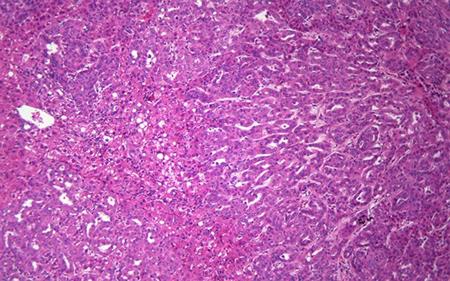By combining RNA sequencing, bioinformatics and mathematical modeling, University of California San Diego School of Medicine and Moores Cancer Center researchers identified a sudden transcriptomic switch that turns healthy liver tissue cancerous. The finding was used to develop a quantitative analytical tool that assesses cancer risk in patients with chronic liver disease and to predict tumor stages and prognosis for patients with liver cancer.
In the December 16, 2019 online edition of the Proceedings of the National Academy of Science (PNAS), Gen-Sheng Feng, PhD, professor of in the Department of Pathology and Section of Molecular Biology, Division of Biological Sciences at UC San Diego, and team describe developing a tumorigenic index score that identifies a shift from healthy to malignant cells.
“Because we do not have an effective drug to treat liver cancer in its late stages, early detection of liver cancer, when a tumor is less than 10 millimeters, allows oncologists to better treat, surgically remove and kill cancer cells,” said Feng, senior author on the paper. “For the first time, we have a mathematical equation that can predict when healthy liver cells become cancerous and, importantly, we are able to detect cancer cells before tumors are visible in a standard clinical setting.”
The new analytical tool focused on the analysis of transcription factor clusters. Transcription factors are proteins that bind to specific DNA sequences in order to direct which genes should be turned on or off in a cell. By quantitatively measuring changes in transcription factors together with downstream target genes as a unit (transcription factor clusters), the research group interrogated RNA-sequencing data collected in the pre-cancer and cancer stages of mouse models with different forms of liver cancer and chronic liver diseases like steatosis, fibrosis and cirrhosis.
The analysis found 61 transcription factor clusters that were either up- or down-regulated in mice with cancer, even identifying transcription factors that have not been previously reported in liver cancer.
Gaowei Wang, PhD, a computational biologist and postdoctoral fellow in Feng’s lab, helped design a comprehensive analysis of a liver cell transcriptome — the entire collection of RNA sequences in a cell. This allowed the team to compare expression of transcription factor clusters in healthy livers and those with chronic liver diseases at various stages to identify when cells became cancerous in mice.
After developing the math model using mouse data, researchers applied the analytical tool to a public database to re-analyze human patient data and were able to identify which people had cancer and which had chronic liver disease. In patients with cirrhosis, who are at high risk of developing cancer, they could see a positive tumor index score and in some cases tumor nodules that were not yet visible in the clinic.
“This mathematical approach can be developed into a risk assessment and early diagnostic tool of liver cancer development for a larger population of people living with chronic liver disease, particularly those with cirrhosis,” said Feng. “The analysis of individuals at high risk may have an important application in precision medicine. And, with further development and optimization, this tool might be modified to predict the development of other cancers.”
According to the American Cancer Society, more than 700,000 new cases of liver cancer are diagnosed globally and 600,000 deaths occur each year, making it among the leading causes of cancer death in the world. In 2019, an estimated 42,000 new cases of liver cancer will be diagnosed and 31,000 people will die in the United States alone.
Further testing is needed before it can be used in a clinical setting. The next step is to analyze liver biopsies, with the ultimate goal of using blood samples to predict risk and stage liver cancer, said Feng.
Co-authors include: Xiaolin Luo, Yan Liang, Kota Kaneko, Hairi Li and Xiang-Dong Fu, all from UC San Diego.
Funding for this research came, in part, from the National Institutes of Health (R01CA188506, R01CA176012).

